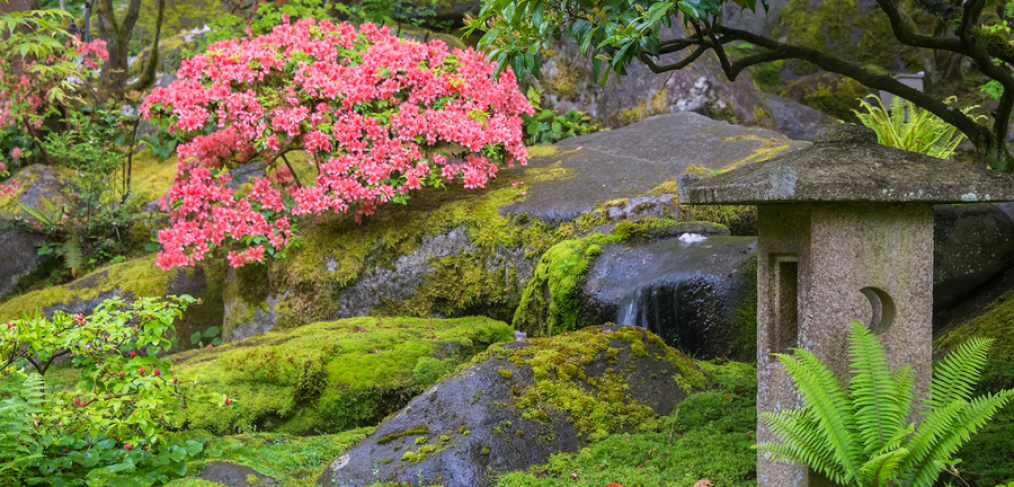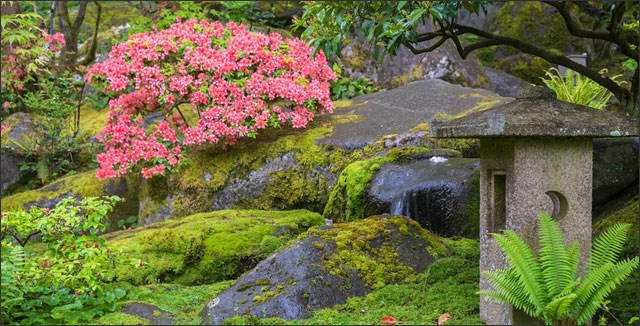
How to Create Your Own Moss Garden

Have you ever thought about creating a moss garden?
Moss gardening is one of the hottest new trends in gardening but it isn’t a new trend at all. As with most trends, the enthusiasm and interest surrounding the practice come and goes, and it’s probably based on something that got perfected centuries ago.
You may be seeing pictures of these beautiful rock and moss gardens floating around online. You may want to know how to create one for yourself. The best thing you can do is to look backward at the traditional Japanese method that’s been around for centuries.
Better yet; if you get a chance to visit a gorgeous Japanese moss garden for yourself, you will come back with a changed perspective.
Because moss grows where it isn’t disturbed, the presence of moss in a garden conveys both a sense of calm and a sense of age. Knowing this, the Japanese cultivate moss to create this sense in their gardening practices.
What Is Moss?
Moss is a plant that was once a water plant which decided to try living on land millions of years ago. This plant is one of the first things to move into any area. You can find moss where you wouldn’t see any other living plant and in all the places in between. Moss is found almost everywhere on the earth except in salt water, both in the tropics and on the poles.
What makes it so successful is that moss doesn’t have leaves, roots, stems or buds. It uses little threads to attach itself to stones, trees or dirt anywhere where conditions are favorable.
Moss likes cool, dark, and moist environments but it has adapted to be very drought tolerant. Therefore, it can thrive in many places where vascular plants can’t.
Moss moves in and breaks down rock and soil which makes the environment more favorable for vascular plants. In the meantime, it helps to control erosion and acts like a sponge to soak up rainfall. Because of this, and its mild antibiotic properties, Sphagnum moss was used in WWII to pack the wounds of soldiers.
Two Main Types of Moss
Although there are thousands of types of moss, it grows in two main ways:
- Upright or Acrocarpous mosses
- Prostrate or Pleurocarpous mosses
As you might imagine, the prostrate version grows faster. Therefore, it is more tolerant of moisture and better at erosion control. It can also be walked on more easily without damage to the plant. The upright versions need to be dried out once in a while to prevent rot, are harder to transplant and to walk on without damaging. All moss is green year-round.
There are a couple of plants we think of as moss that aren’t moss – like Irish moss and Scotch moss. These plants thrive in similar locations and they look similar. However, they are evergreen perennials and not moss.
Benefits of Moss to Your Yard
Not only does moss offer many options for softening a rocky landscape and creating a fairy-like ambiance in your garden, but it also benefits your garden in many ways:
- Moss retains moisture and is one of the most drought-tolerant plants out there. Americans regularly use 10,000 gallons of water per year to water their lawns. In addition, moss requires less than 1 percent of this amount of water to survive.
- Moss can be used as an effective replacement for mulch for this reason but is much better at its job than mulch could ever hope to be. Moss doesn’t just sit there. It processes nutrients and contributes organic material to the rest of your garden. It doesn’t need replacing every year, and it hosts beneficial insects.
- Because Moss isn’t a vascular plant like most plants, it can handle being walked on without being damaged as long as the patch you’re walking on isn’t subject to running or sliding. If you have a shady yard and a desire never to do lawn care again, you could replace your entire yard with moss!
Moss Misconceptions
- Moss and mold go together – A common myth about moss is that it shows up where mold is growing, or that it’s an allergen similar to mold. Nothing could be further from the truth! In fact, mold attacks moss in the same way it can attack anything else organic, so they are almost never found together. And although moss spores do fly through the air in a similar way to mold, it’s very uncommon for anyone to have an allergy to moss.
- Moss is a parasite – Not true! Moss does not feed on the substrate upon which it grows or clings. The one thing you may need to watch out for, however, is that moss may keep the substrate damp for long periods of time, which can contribute to the faster breakdown of some organic materials.
- Moss will attract fleas, ticks, and mosquitoes – Nothing could be further from the truth! These pests need taller plants in which to shelter. Moss is too dense and short to attract them.
How to Grow Your Own Moss Garden
You may now be saying to yourself, “sign me up!” How do I make a moss garden of my very own?
The answer is pretty simple: all you need is a smooth surface.
If what you want to do is encourage moss growth between, around or on top of an existing stone garden, make sure you don’t also have metal or treated lumber nearby. Moss doesn’t like to drink water which comes into contact with heavy metals (treated lumber is treated with a heavy metal). You may have success planting on top of some soil in a metal container, as long as the metal is “downstream” from your moss. Same with treated lumber window boxes.
If you are hoping to transplant moss over an area that was once grass, you will first need to remove all the grass and get the terrain down to bare dirt. Moss isn’t particular about the nutrient value of the soil upon which it grows, so this isn’t a concern.
The concern is that there is no loose debris or moving dirt, which will keep the moss from being able to make contact with the earth. This doesn’t mean you can’t plant moss around companion plants. However, you do have to keep the area weeded while the moss is getting established.
Transplanting moss from other areas of your yard may be effective as long as you pay attention to, and try to mimic the original conditions. You can also purchase square footage of moss from a specialty moss nursery. Then, spread it over a larger area in small clumps.
In either case, if the conditions are favorable, you can use small pins or netting to hold the rhizomes in place while they are attaching themselves to the ground.
What Won’t Work
You may have seen one of those popular posts about “painting” moss onto the side of your building using a blended mixture of buttermilk and moss. This is likely to end up being a moldy mess. The same goes for beer or manure.
What moss needs is shade, moisture, and time to itself. If you want a moss slogan on the shady side of your house, by all means, make it happen. However, this will mean some careful cutting and pinning while you wait to get it established.
Conclusion
In addition to this, moss will need to be watered frequently while it’s getting established. This is especially true for the prostrate varieties. After that, however, your moss garden should take care of itself. It will make your yard into a serene, magical place in which to rest.



